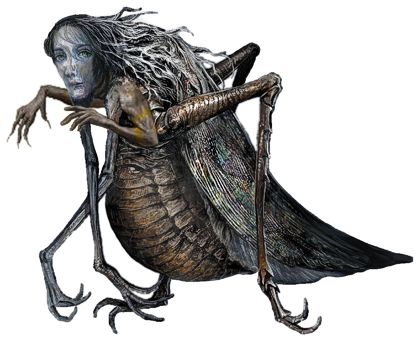

Book of Souls

| Climate/Terrain: | Any |
|---|---|
| Frequency: | Unique |
| Organization: | Swarm |
| Activity Cycle: | Any |
| Diet: | Omnivore |
| Intelligence: | Very (11) |
| Treasure: | Nil |
| Alignment: | Neutral |
| No. Appearing: | 1d10 × 200 |
| Armor Class: | 4 |
| Movement: | 6 (Fl 18) |
| Hit Dice: | 1 |
| THAC0: | 16 |
| No. of Attacks: | 2 |
| Damage/Attack: | 1d4+2/1d2 |
| Special Attacks: | Swarm attack |
| Special Defenses: | Blind, Charm |
| Magic Resistance: | 90% (25% against fire magic) |
| Size: | T (approx. 1’) |
| Morale: | Champion (15) |
| XP Value: | Varies |
Doom locusts, also called hungerbabies, are harbingers of doom and destruction that appear throughout the lands of Ravenloft. They have the form of large locusts with the features of small children and wings of stained glass. Their heads are those of infants with compound eyes and powerful mandibles. They have six legs, two of which are the withered arms of young children, and the remainder being thorned, insectile legs. Individually, the call of a doom locusts sounds very much like the weeping of children, but collectively, these cries unite as a great voice chanting “Doom, doom.” These creatures descend in great swarms upon places that are doomed. The destruction that follows is not caused by the doom locusts, but by an outside source, be it famine, war, or other form of destruction. The doom locusts are not the cause of doom, but rather, the symptom.
Combat: Doom locusts always travel in swarms, and never attack singly (typically 5-10 locusts at a time). Rather, they attack in groups, literally covering a person and biting them to death. Additionally, when doom locusts are close enough to a person to bite, they inflict an additional 1d2 points of damage by clawing and scratching their victims. Twice a day, the entire swarm may descend upon and attack a single creature. Surrounded by a screaming whirlwind of locust-things, the focus of the attack must make a saving throw vs. wands or be stripped to the bone by the ravenous host. Should the roll succeed, the target breaks free of the swarm suffering 4d6+2 damage from the feeding swarm. Also note that because the doom locusts can bite through metal and stone, they treat all Armor Classes are two levels lower than normal.
The wings of doom locusts are highly reflective, resembling sections of stained glass. In bright conditions, lights shining off their wings has a 25% chance to blind a random opponent every other round. In addition to this form of defense, the hungerbabies have a more unusual defense – a highly specialized charm ability. Should any female attempt to harm a doom locust, she is affected as by a charm spell. Those affected will believe that the doom locust has the face of her child, regardless of whether she actually has any children. There after, she will refuse to allow harm to come to the hungerbabies.
Doom locusts are vulnerable to magical fire. In addition, individual doom locusts can be turned as though they were mummies. However, the swarm can not be driven away unless the doom they presage is averted. If the coming doom is not averted by midnight of the night the last doom locust is destroyed, the entire swarm will resurrect and continue to plague the region.
Habitat/Society: The doom locusts are harbingers of doom that plague the lands of Ravenloft. It is believed that a single swarm exists as no records of simultaneous swarms exist. The doom locusts descend upon a place approximately one week prior to the doom that is to befall. Once there, they settle in the outskirts of the region and for a single day do nothing but cry their mournful song. As the last doom locust stills its voice, the graves of children open throughout the area, releasing a new host of doom locusts. Then, the doubled host of locust-things proceed to feast upon the doomed site, devouring plants, dirt, animals, wood, stone, even metal and people. Oddly, the damage is rarely as bad as that of a natural locust plague. The night prior to the devastation, the locusts fly into the darkness. With the new day, the area is destroyed but the prophesied doom.
Tales of the doom locusts are found throughout Ravenloft, often in religious texts. Reports of hordes of giant locusts who carried off children flourished prior to the Grand Conjunction. Similar accounts cropped up in Darkon immediately before the Grim Harvest. G’Henna is known to be frequently visited by the doom locusts as are the Burning Peaks.
Ecology: The doom locusts are unnatural creatures, giving nothing to the land, bringing destruction in their wake. When doom locusts are slain, they burst into flame and melt into puddles of black and toxic sludge. Many scholars claim that doom locusts are a unique type of undead.
Author’s Note: The doom locusts are derived from Apocalypse by Nancy Springer and from the Revelation of St. John of Patmos. Generally, the doom locusts are a plot device to herald a major event in a campaign.
